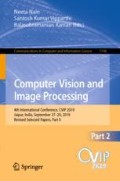Abstract
Alteration of words in handwritten financial documents such as cheques, medical claims, and insurance claims may lead to monetary loss to the customers and financial institutions. Hence, automatic identification of such alteration in documents is a crucial task. Therefore, an ink color based analysis using Convolutional Neural Network (CNN) automation method has been introduced for alteration detection. Pre-trained AlexNet and VGG-16 architectures have been used to study the effect of transfer learning on the problem at hand. Further, two different shallow CNNs have been employed for recognition. A data set has been created using ten blue and ten black pens to simulate the word alteration problem. The dataset captures the word alteration by addition of the characters (or even pen strokes) in the existing word. Experiments have revealed that the transfer learning based deep CNN architectures have outperformed the shallow CNN architectures on both blue and black pens.
Access this chapter
Tax calculation will be finalised at checkout
Purchases are for personal use only
References
DIAL word alteration dataset. https://sites.google.com/site/diafcse/resources/dial-word-alteration-dataset
Boufenar, C., Kerboua, A., Batouche, M.: Investigation on deep learning for off-line handwritten Arabic character recognition. Cognit. Syst. Res. 50, 180–195 (2018)
Chhabra, S., Gupta, G., Gupta, M., Gupta, G.: Detecting fraudulent bank checks. In: Advances in Digital Forensics XIII, pp. 245–266 (2017)
Dansena, P., Bag, S., Pal, R.: Differentiating pen inks in handwritten bank cheques using multi-layer perceptron. In: International Conference on Pattern Recognition and Machine Intelligence, pp. 655–663 (2017)
Dasari, H., Bhagvati, C.: Identification of non-black inks using HSV colour space. In: International Conference on Document Analysis and Recognition, pp. 486–490 (2007)
Deng, J., Dong, W., Socher, R., Li, L.J., Li, K., Fei-Fei, L.: ImageNet: a large-scale hierarchical image database. In: International Conference on Computer Vision and Pattern Recognition, pp. 248–255 (2009)
Gorai, A., Pal, R., Gupta, P.: Document fraud detection by ink analysis using texture features and histogram matching. In: International Joint Conference on Neural Networks, pp. 4512–4517 (2016)
Harris, J.: Developments in the analysis of writing inks on questioned documents. J. Forensic Sci. 37(2), 612–619 (1992)
Hollander, M., Wolfe, D.A., Chicken, E.: Nonparametric statistical methods, vol. 751. Wiley, Hoboken (2013)
Krizhevsky, A., Sutskever, I., Hinton, G.E.: Imagenet classification with deep convolutional neural networks. In: Advances in Neural Information Processing Systems, pp. 1097–1105 (2012)
Kumar, R., Pal, N.R., Chanda, B., Sharma, J.: Forensic detection of fraudulent alteration in ball-point pen strokes. IEEE Trans. Inf. Forensics Secur. 7(2), 809–820 (2012)
Kumar, R., Pal, N.R., Sharma, J.D., Chanda, B.: A novel approach for detection of alteration in ball pen writings. In: International Conference on Pattern Recognition and Machine Intelligence, pp. 400–405 (2009)
LeCun, Y.A., Bottou, L., Orr, G.B., Müller, K.R.: Efficient backprop. In: Neural Networks: Tricks of the Trade, pp. 9–48 (2012)
Lei, L., Zhu, H., Gong, Y., Cheng, Q.: A deep residual networks classification algorithm of fetal heart CT images. In: International Conference on Imaging Systems and Techniques, pp. 1–4 (2018)
Liu, X., Wang, C., Hu, Y., Zeng, Z., Bai, J., Liao, G.: Transfer learning with convolutional neural network for early gastric cancer classification on magnifiying narrow-band imaging images. In: International Conference on Image Processing, pp. 1388–1392 (2018)
Meyer, B.J., Harwood, B., Drummond, T.: Deep metric learning and image classification with nearest neighbour gaussian kernels. In: International Conference on Image Processing, pp. 151–155 (2018)
Pereira, J.F.Q., et al.: Projection pursuit and PCA associated with near and middle infrared hyperspectral images to investigate forensic cases of fraudulent documents. Microchem. J. 130, 412–419 (2017)
Pramanik, R., Dansena, P., Bag, S.: A study on the effect of CNN-based transfer learning on handwritten Indic and mixed numeral recognition. In: Workshop on Document Analysis and Recognition, pp. 41–51 (2018)
Roy, S., Sangineto, E., Sebe, N., Demir, B.: Semantic-fusion gans for semi-supervised satellite image classification. In: International Conference on Image Processing, pp. 684–688 (2018)
Simonyan, K., Zisserman, A.: Very deep convolutional networks for large-scale image recognition (2014). arXiv preprint arXiv:1409.1556
Suzuki, M., Akiba, N., Kurosawa, K., Akao, Y., Higashikawa, Y.: Differentiation of black writing ink on paper using luminescence lifetime by time-resolved luminescence spectroscopy. Forensic Sci. Int. 279, 281–287 (2017)
Too, E.C., Yujian, L., Njuki, S., Yingchun, L.: A comparative study of fine-tuning deep learning models for plant disease identification. Comput. Electron. Agric. 161, 272–279 (2018)
Tushar, A.K., Ashiquzzaman, A., Afrin, A., Islam, M.R.: A novel transfer learning approach upon Hindi, Arabic, and Bangla numerals using convolutional neural networks. In: Computational Vision and Bio Inspired Computing, pp. 972–981 (2018)
Wang, X.F., Yu, J., Xie, M.X., Yao, Y.T., Han, J.: Identification and dating of the fountain pen ink entries on documents by ion-pairing high-performance liquid chromatography. Forensic Sci. Int. 180(1), 43–49 (2008)
Author information
Authors and Affiliations
Corresponding author
Editor information
Editors and Affiliations
Rights and permissions
Copyright information
© 2020 Springer Nature Singapore Pte Ltd.
About this paper
Cite this paper
Dansena, P., Pramanik, R., Bag, S., Pal, R. (2020). Ink Analysis Using CNN-Based Transfer Learning to Detect Alteration in Handwritten Words. In: Nain, N., Vipparthi, S., Raman, B. (eds) Computer Vision and Image Processing. CVIP 2019. Communications in Computer and Information Science, vol 1148. Springer, Singapore. https://doi.org/10.1007/978-981-15-4018-9_21
Download citation
DOI: https://doi.org/10.1007/978-981-15-4018-9_21
Published:
Publisher Name: Springer, Singapore
Print ISBN: 978-981-15-4017-2
Online ISBN: 978-981-15-4018-9
eBook Packages: Computer ScienceComputer Science (R0)

